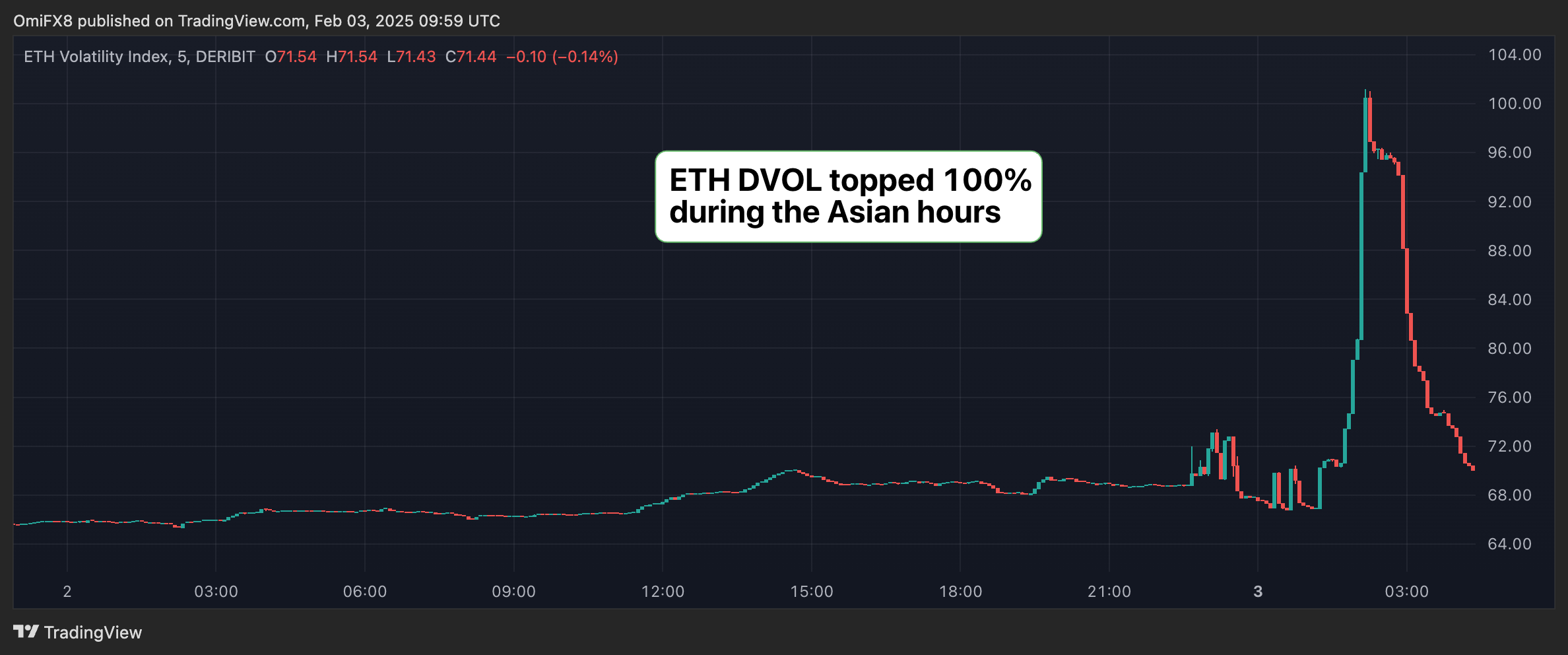Ether Experiences Significant Volatility Amid Trade War Fears

Ether (ETH), the cryptocurrency that ranks second in market capitalization, faced a dramatic surge in volatility early on Monday. This upheaval was largely triggered by the resurgence of trade tensions between the United States and its trading partners, leading to widespread risk aversion across financial markets. During this tumultuous period, the price of ether plummeted as much as 24%, resulting in considerable dislocations across various centralized exchanges.
On Deribit, the price of ether reached a low of $2,065, while on Kraken it fell to $2,127 and on Coinbase (COIN) it dropped to $2,150. This marked the lowest point since the crash on August 5, according to data from TradingView and CoinDesk. Notably, this decline is reported to be the most significant since May 19, 2021, as per CryptoQuant. Over the course of three consecutive days, the token associated with the Ethereum blockchain lost a staggering 23%, representing the largest drop since November 2022. In contrast, Bitcoin (BTC) experienced a more modest decline of just over 5%, settling at $91,200.
As the price of ether fell, its one-day at-the-money volatility surged dramatically from an annualized 34% to an astonishing 184%, as highlighted by Deribit’s options data tracked by Presto Research. Furthermore, Deribit’s ether DVOL index, which gauges expected price fluctuations over the next four weeks, also soared, increasing from approximately 67% to 101%, as illustrated by TradingView data.
This volatility spike coincided with traders rapidly purchasing ETH put options, which provide a form of downside protection, according to Presto Research. Min Jung, an analyst at Presto Research, noted, “The dramatic movement, which saw ETH perpetual prices on Deribit plummet from $3,285 to $2,065, has triggered a significant shift in market positioning. This is evidenced by the put-call ratio skyrocketing from last week’s relatively stable 0.6 to over 2.5 today, indicating a frantic rush for downside protection among market participants.”
At one point during this tumultuous trading session, risk reversals—indicators that measure the implied volatility premium for calls in relation to puts—showed negative values exceeding 10%, reflecting an unusually strong bias towards puts.
Market Makers Contribute to Increased Volatility
Part of the volatility can be attributed to market makers pulling back liquidity, a common response during periods of heightened market fluctuations. Griffin Ardern, head of options trading and research at the crypto financial platform BloFin, explained, “Some market makers opted to withdraw liquidity during this high-volatility environment, and their risk-averse behavior has a direct impact on options pricing.”
Furthermore, Markus Thielen, head of 10x Research, pointed out that delta hedging by market makers intensified the downward volatility in ETH. He stated, “As market makers and exchanges rushed to offload futures, they sold at any available bid, which accelerated the sell-off.” Market makers play a crucial role in providing liquidity to the order book and typically profit from the bid-ask spread. They maintain a net market (delta) neutral exposure through continuous buying and selling of futures. In scenarios where they hold short gamma exposure, they tend to sell into weakness or buy into strength, further contributing to the prevailing market momentum.
Trade War Concerns Impact Market Sentiment
The swift decline in the price of ether has raised speculation that a significant fund or trader with ETH-margined positions in derivatives or decentralized finance (DeFi) may have faced liquidation, exacerbating the price drop. However, the broader market downturn, including the slide in ETH, appears to have been primarily driven by renewed trade tensions between the United States and countries such as Canada, Mexico, and China. Analysts express concern that these trade disputes could introduce inflationary pressures into the global economy, complicating efforts by central banks—including the Federal Reserve—to lower interest rates and foster economic growth. This apprehension has also spilled over into traditional markets, with Dow futures dropping more than 650 points early in the day, while European stock futures mirrored this decline alongside a rise in the dollar.







